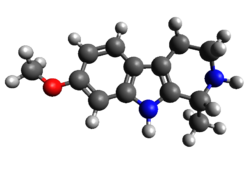Chemistry:Tetrahydroharmine
 | |
 | |
| Clinical data | |
|---|---|
| Other names | THH; 1,2,3,4-Tetrahydroharmine; Leptaflorine; 2,3,4,9-Tetrahydro-7-methoxy-1-methyl-1H-pyrido(3,4-b)indole |
| Legal status | |
| Legal status |
|
| Identifiers | |
| |
| CAS Number | |
| PubChem CID | |
| ChemSpider | |
| UNII | |
| KEGG | |
| ChEBI | |
| ChEMBL | |
| Chemical and physical data | |
| Formula | C13H16N2O |
| Molar mass | 216.284 g·mol−1 |
| 3D model (JSmol) | |
| |
| |
Tetrahydroharmine (THH) is a fluorescent indole alkaloid that occurs in the tropical liana species Banisteriopsis caapi.[1]
THH, like other harmala alkaloids in B. caapi, namely harmaline and harmine, is a reversible inhibitor of monoamine oxidase A (RIMA),[2] but it also inhibits the reuptake of serotonin.[3]
THH contributes to B. caapi's psychoactivity as a serotonin reuptake inhibitor.[4]
Legal Status
Australia
Harmala alkaloids are considered Schedule 9 prohibited substances under the Poisons Standard (October 2015).[5] A Schedule 9 substance is a substance which may be abused or misused, the manufacture, possession, sale or use of which should be prohibited by law except when required for medical or scientific research, or for analytical, teaching or training purposes with approval of Commonwealth and/or State or Territory Health Authorities.[5]
See also
References
- ↑ "Various alkaloid profiles in decoctions of Banisteriopsis caapi". Journal of Psychoactive Drugs 37 (2): 151–155. June 2005. doi:10.1080/02791072.2005.10399796. PMID 16149328.
- ↑ "Monoamine oxidase inhibition in brain and liver produced by beta-carbolines: structure-activity relationships and substrate specificity". Biochemical Pharmacology (Elsevier BV) 26 (21): 1991–1996. November 1977. doi:10.1016/0006-2952(77)90007-7. PMID 921812.
- ↑ "The alkaloids of Banisteriopsis caapi, the plant source of the Amazonian hallucinogen Ayahuasca, stimulate adult neurogenesis in vitro". Scientific Reports (Springer Science and Business Media LLC) 7 (1): 5309. July 2017. doi:10.1038/s41598-017-05407-9. PMID 28706205.
- ↑ "Pharmacokinetics of Hoasca alkaloids in healthy humans". Journal of Ethnopharmacology 65 (3): 243–256. June 1999. doi:10.1016/S0378-8741(98)00168-8. PMID 10404423.
- ↑ 5.0 5.1 "Poisons Standard October 2015". Australian Government Department of Health. September 2015. https://www.comlaw.gov.au/Details/F2015L01534.
Further reading
- "Tetrahydroharmine". TiHKAL: The Continuation. 1997. http://www.erowid.org/library/books_online/tihkal/tihkal54.shtml.
 |

